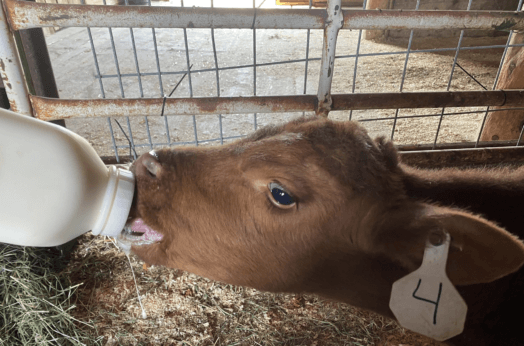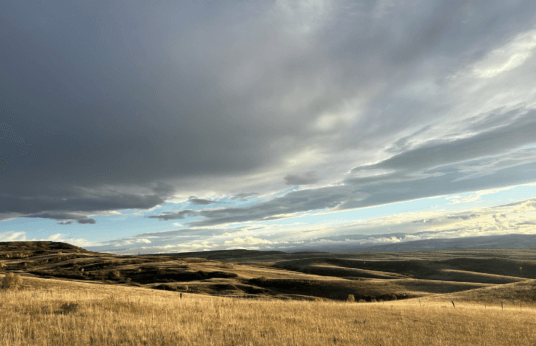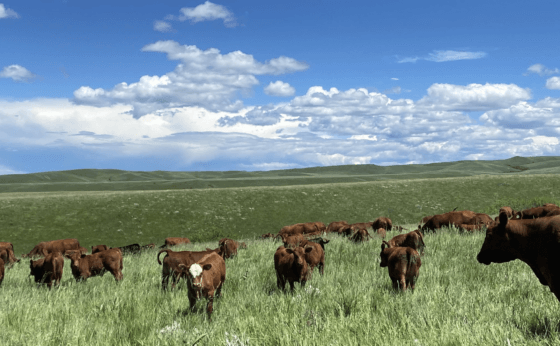Meet the Ranchers Trying to Restore Grasslands
With millions of acres of grasslands disappearing across the US every year, some ranchers are trying to restore native grasses to the prairie, while keeping their herds intact.
Meet the Ranchers Trying to Restore Grasslands
With millions of acres of grasslands disappearing across the US every year, some ranchers are trying to restore native grasses to the prairie, while keeping their herds intact.

Steward's herd grazes along part of her range. submitted by Mickey Steward.
Mickey Steward has worked hard to rehabilitate her ranch. But then, she’s had to. “You can’t buy a good ranch,” Steward jokes. “You have to buy a ranch that, for whatever reason, has gotten rundown.” While not a blanket truth, Steward says it’s hard (and expensive) for new ranchers to get in the game with “good” land. So, she’s learned how to build her land back up.
Steward runs Red Angus cattle on about 1,000 acres of land over the Crow Reservation in Montana, right at the foot of the Bighorn Mountains. She and her husband started ranching in their late 20s, and they’ve been at it for more than 40 years now. “We started with a little ranch north of Gillette, Wyoming. We had nothing—no knowledge, no equipment. We had 65 cows and a book that told us how to pull a calf.”

Over the decades, Steward has grown her operation and is now working her third ranch. She’s learned a few things over the years and likens the perfect balance of a grassland to “Goldilocks porridge.” Keeping the ground temperature steady, maintaining adequate soil moisture, moving the cattle at the right pace…it’s a lot to keep in mind. Steward works to keep track of everything by sectioning off her acres with electric fencing and moving her cattle in time with seasonal changes. In the spring, Steward moves her cattle out to pastures that have rested over the winter, but by the long heat of the summer, she’s wary of the ground getting too hot and baking, so she maintains a good litter cover while moving her cattle into shaded areas. “We try to bring back the climax vegetation, to encourage the vegetation to return to its most productive and stable state,” says Steward. It’s a difficult job to keep grasslands across the US in the best shape possible. In part, that’s because they keep disappearing.
In 2021, roughly 1.6 million acres of grasslands across the Canadian and US Great Plains were plowed over. Since 2012, we’ve lost nearly 32 million acres, some to development, some to the expansion of farming. It’s not the fault of any one farmer, and Steward is quick to point out that ranchers couldn’t survive without farmers. But she does worry about the loss of ranchland. “The grasslands and rangelands are like the lungs of the body,” she says. “We have to have a balance. And we have to preserve those lungs, the grasslands and rangelands and open spaces.”

It is tough for ranchers to stick with ranching, however, when large-scale farming can often prove more profitable for the same acreage—at least, initially. “A lot of the new land that’s getting plowed up is soil that isn’t necessarily going to sustain farming for the long term. It’s marginal soil,” says Alexis Bonogofsky, manager of the World Wildlife Fund’s Sustainable Ranching Initiative (SRI). A rancher herself, Bonogofsky raises ewes on about 100 acres outside of Billings, Montana, and works with ranchers, including Steward, to restore their grasslands and make it more profitable to stay in ranching long term. “Preventing that marginal soil from getting tilled up is a goal of ours. If we can make ranching a viable economic activity on that land, we’re helping to keep that grass.”
Keeping grasslands, and ensuring they are performing at their peak, has incredible benefits to wildlife habitat, water quality and carbon sequestration. “Healthy grasslands, with good grazing, can actually increase the amount of carbon that is sequestered in the soil. The northern Great Plains is one of four intact grassland ecosystems in the world,” says Bonogofsky. It can be hard for folks to see the importance of this ecosystem, she says, especially if they haven’t really seen a grassland up close. “The prairies is one of the most biodiverse ecosystems we have. I worry that people don’t understand the value of the prairie, and, therefore, might not be interested in protecting them…Grasslands can support grass-based economies and rural communities and wildlife all at the same time.”
And one way to keep the grasslands healthy is, perhaps, a little counterintuitive: grazing.
Grass is meant to be grazed; it’s how the roots get stronger and more secure and how the soil quality improves. But overgrazing, which tends to happen with too many animals on too small a parcel of land, has the opposite effect. Rather than strengthening the soil, overgrazing weakens root systems, resulting in patchy plant clusters and dismal topsoil. Steward worked with Bonogofsky and the SRI program to come up with a rotational program.

They keep their herd on a relatively small paddock for a few days, then move them, but not by much. It’s a short shift over, but it allows the grasses that were just grazed enough time to recover. “You can’t run cattle and maintain a stable, diverse grasslands environment if you don’t control how long the grazing lasts, how hard the grazing is and how much physical impact the animals bring to the landscape,” says Steward. “You’re both mimicking the natural environment and encouraging it to be the best that it can be.”
When Steward first started with the SRI program, advisors came to the ranch and did a bunch of soil sampling. At the time, roughly 10 years ago, they found an average of three perennial grasses and plenty of bare ground. Now, a decade later, Steward says there’s an average of 12 native grasses, with a solid ground cover. “It’s about a 30-percent increase in productivity,” says Steward.
The history of ranching, says Steward, is a fairly extractive one. “There was no real thought for balanced utilization. Now, we’ve gotten ourselves to the point where we need to regenerate the landscape,” she says. “We can make it the best it can be. And I firmly believe that livestock, because it’s a grassland that evolved with grazing animals, is the best way to do it.”
***
Learn more about the WWF’s rangeland program, and the conditions which shaped the current state of Nebraska rangeland.
Follow us

This work is licensed under a Creative Commons Attribution-NoDerivatives 4.0 International License.
Want to republish a Modern Farmer story?
We are happy for Modern Farmer stories to be shared, and encourage you to republish our articles for your audience. When doing so, we ask that you follow these guidelines:
Please credit us and our writers
For the author byline, please use “Author Name, Modern Farmer.” At the top of our stories, if on the web, please include this text and link: “This story was originally published by Modern Farmer.”
Please make sure to include a link back to either our home page or the article URL.
At the bottom of the story, please include the following text:
“Modern Farmer is a nonprofit initiative dedicated to raising awareness and catalyzing action at the intersection of food, agriculture, and society. Read more at <link>Modern Farmer</link>.”
Use our widget
We’d like to be able to track our stories, so we ask that if you republish our content, you do so using our widget (located on the left hand side of the article). The HTML code has a built-in tracker that tells us the data and domain where the story was published, as well as view counts.
Check the image requirements
It’s your responsibility to confirm you're licensed to republish images in our articles. Some images, such as those from commercial providers, don't allow their images to be republished without permission or payment. Copyright terms are generally listed in the image caption and attribution. You are welcome to omit our images or substitute with your own. Charts and interactive graphics follow the same rules.
Don’t change too much. Or, ask us first.
Articles must be republished in their entirety. It’s okay to change references to time (“today” to “yesterday”) or location (“Iowa City, IA” to “here”). But please keep everything else the same.
If you feel strongly that a more material edit needs to be made, get in touch with us at [email protected]. We’re happy to discuss it with the original author, but we must have prior approval for changes before publication.
Special cases
Extracts. You may run the first few lines or paragraphs of the article and then say: “Read the full article at Modern Farmer” with a link back to the original article.
Quotes. You may quote authors provided you include a link back to the article URL.
Translations. These require writer approval. To inquire about translation of a Modern Farmer article, contact us at [email protected]
Signed consent / copyright release forms. These are not required, provided you are following these guidelines.
Print. Articles can be republished in print under these same rules, with the exception that you do not need to include the links.
Tag us
When sharing the story on social media, please tag us using the following: - Twitter (@ModFarm) - Facebook (@ModernFarmerMedia) - Instagram (@modfarm)
Use our content respectfully
Modern Farmer is a nonprofit and as such we share our content for free and in good faith in order to reach new audiences. Respectfully,
No selling ads against our stories. It’s okay to put our stories on pages with ads.
Don’t republish our material wholesale, or automatically; you need to select stories to be republished individually.
You have no rights to sell, license, syndicate, or otherwise represent yourself as the authorized owner of our material to any third parties. This means that you cannot actively publish or submit our work for syndication to third party platforms or apps like Apple News or Google News. We understand that publishers cannot fully control when certain third parties automatically summarize or crawl content from publishers’ own sites.
Keep in touch
We want to hear from you if you love Modern Farmer content, have a collaboration idea, or anything else to share. As a nonprofit outlet, we work in service of our community and are always open to comments, feedback, and ideas. Contact us at [email protected].by Emily Baron Cadloff, Modern Farmer
January 20, 2024
Modern Farmer Weekly
Solutions Hub
Innovations, ideas and inspiration. Actionable solutions for a resilient food system.
ExploreExplore other topics
Share With Us
We want to hear from Modern Farmer readers who have thoughtful commentary, actionable solutions, or helpful ideas to share.
SubmitNecessary cookies are absolutely essential for the website to function properly. This category only includes cookies that ensures basic functionalities and security features of the website. These cookies do not store any personal information.
Any cookies that may not be particularly necessary for the website to function and are used specifically to collect user personal data via analytics, ads, other embedded contents are termed as non-necessary cookies.
It’s not a farmer. I’m a consumer who lives in the suburbs. I have been worried for years that our farmers are being pushed out by commercial farming operations and out of control development. I am pleased with the efforts of organizations mentioned in modern farmer and happy to read about success stories. Thank you for your efforts that so many don’t notice.
I live in Ossining, NY, so I hesitate to question the way people earn their living on The Great Plains. But I have been reading about a couple of things that were not mentioned in this article: The contamination of the atmosphere caused by cattle excrement, and the promising work now underway that burns the Eastern Red Cedar, which have invaded the grasslands. Also reading a classic book by Ian Frazier, GREAT PLAINS. Thanks from a non-farmer for your emails.
Am in Ohio SE trying to find which grass to grow for sheep that might last through the winter.
So far, I think Rye grass, Kentucky blue grass and orchard grass. Which legumes are good also?
I am new comer in the USA, I need to become a rancher. Due to the changes of seasons I want to have all the informations about the processes the rancher follows in the four different seasons of the year. I am a rancher in my home country “the Democratic Republic of Congo.
Getting all soil to grow grass for Grayson
I found your article very informative. Do keep posting such articles! Thank You.